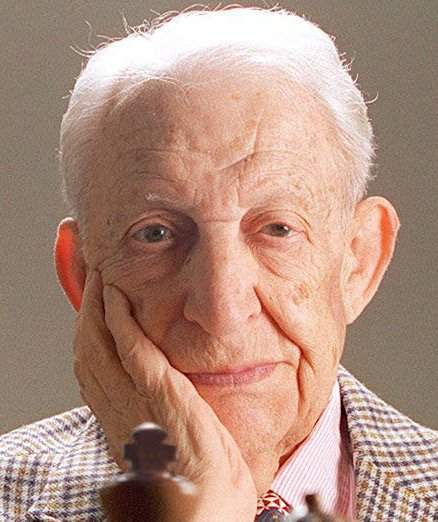
I first met George Koltanowski at the 1959 US Open in Omaha, when I was 14 years old. I arrived at the tournament seven rounds late. I was late because I lived in Virginia. Every Summer, my mother, who was originally from Iowa, drove us to Creston, Iowa to meet our relatives. I was able to go 100 miles further to Omaha to play in the last part of the US Open.
 |
Years later, at the 1966 US Open in Seattle, Peter Cleghorn was among the leaders. Cleghorn was a terrific player who could have been a grandmaster, but he tended to live in areas where not much chess was played. I had played in Cleghorn's first rated tournament, which was in October, 1962. Cleghorn had won with an overwhelming score. Cleghorn was already at least a 2300 player when he played his first rated game of chess.
In the 1966 US Open in Seattle, Cleghorn was playing Grandmaster Benko. An endgame was reached with a locked pawn structure. Koltanowski, who was the director of every US Open from 1946 until the late 1970s, came to the board with a sealed move envelope. Since sealed move envelopes are no longer used in this age of computers, I need to explain that when a game was adjourned for the night, one player would seal his move in an envelope, which would be opened the next day when play was resumed. In this way, each player would know what his own last move was and would not know what his opponent's next move would be.
I did not notice Koltanowski give more than a glance at the position on the board. After the move had been sealed and Koltanowski had taken the envelope, I and several others analyzed the position with Cleghorn. The result of our analysis was that Cleghorn had a win. If Benko's king moved to the right, Cleghorn's king would go to the left and break through and win. On the other hand, if Benko's king moved to the left, then Cleghorn's king would go to the right and break through and win.
We analyzed for well over an hour and nobody could find a way for Benko to hold a draw.
After almost everyone had disbursed, I went up to Koltanowski, who was sitting at the tournament director's table planning the pairings for the next round. I happened to say something about the Benko-Cleghorn game. Koltanowski said, "The game is a draw."
"What do you mean?," I said. "We just analyzed the position for over an hour and Cleghorn wins in all variations. If Benko's king goes to the right, Cleghorn's king goes to the left and wins. If Benko's king goes to the left, Cleghorn's king goes to the right and wins. No matter where Benko's king goes, Cleghorn wins."
"Yes," Koltanowski said. "But what if Benko's king does not move at all? What if it stays exactly where it is?"
We went back and looked. Koltanowski was right. If Benko's king just marked time in the middle and waited for Cleghorn to take aggressive action, there was no way for Cleghorn to win. If Cleghorn's king went right, Benko's king also went right. If Cleghorn's king went left, Benko's king also went left. In either case, Benko's king would arrive just in time to stop Cleghorn from breaking through.
Benko had long since gone to his hotel room to analyze the position himself.
The next morning, the players came down and sat down to play. Koltanowski opened the sealed move envelope. The sealed move was played on the board and the clock was started.
Benko moved his king to the right. Cleghorn moved his king to the left. Cleghorn's king broke through and won the game.
Grandmaster Benko, a famous authority on endgame technique, had not seen a drawing idea which Koltanowski had seen in just a brief glance at the board, while receiving the sealed move envelope.
Unfortunately, the game has never been published.
Sam Sloan
P.S. Peter Cleghorn moved to Alaska and virtually dropped out of chess after that, emerging only occasionally to play in Lone Pine.